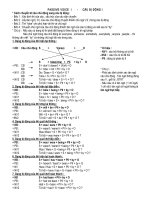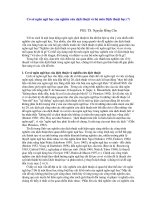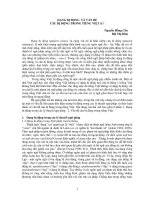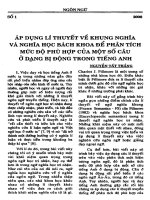Passive form dạng bị động
Bạn đang xem bản rút gọn của tài liệu. Xem và tải ngay bản đầy đủ của tài liệu tại đây (74.96 KB, 5 trang )
CÂU BỊ ĐỘNG (Passive voice)
I- PHÂN BIỆT CÂU CHỦ ĐỘNG VÀ CÂU BỊ ĐỘNG
1. Câu chủ động:
* Cách sử dụng:
Câu chủ động là câu được sử dụng khi bản thân chủ thể được nhắc đến tự thực hiện hành động
Ví dụ:
Mary did her homework yesterday. (Mary làm bài tập về nhà ngày hôm qua.)
Ta thấy chủ thể được nhắc đến trong câu này là “Mary” và bản thân chủ thể này có thể tự thực
hiện việc “làm bài tập về nhà”. Vây nên ta sử dụng câu chủ động.
* Dạng thức thông thường của câu chủ động:
S+V+O
Trong đó:
S(subject): Chủ ngữ
V (verb): động từ
O (object): tân ngữ
CHÚ Ý:
- Động từ trong câu sẽ chia theo thì.
Ví dụ:
- My parents are preparing a lot of delicious cakes.
S
V
O
Ta thấy chủ thể “bố mẹ tôi” hoàn toàn có thể tự thực hiện việc “chuẩn bị rất nhiều bánh ngon”.
Động từ “prepare” chia theo thì hiện tại tiếp diễn.
2. Câu bị động:
* Cách sử dụng:
- Câu bị động được sử dụng khi bản thân chủ thể không tự thực hiện được hành động.
Ví dụ:
- My money was stolen yesterday. (Tiền của tôi bị trộm mất ngày hôm qua.)
Ta thấy chủ thể là “tiền của tôi” không thể tự “trộm” được mà bị một ai đó “trộm” nên câu này ta
cần sử dụng câu bị động.
* Dạng thức của câu bị động.
be + VpII
Trong đó:
be: động từ “to be”
VpII: Động từ phân từ hai
CHÚ Ý:
Động từ “to be” sẽ chia theo thì và chia theo chủ ngữ.
Ví dụ:
- The meal has been cooked. (Bữa ăn vừa mới được nấu.)
Ta thấy “bữa ăn” không thể tự thực hiện việc “nấu” nên ta cần sử dụng câu bị động. Động từ “to
be” chia thì hiện tại hoàn thành với chủ ngữ là ngôi thứ 3 số ít nên có dạng là “has been + cooked
(động từ phân từ hai).
1
II- CÂU BỊ ĐỘNG
1. Cấu trúc biến đổi từ câu chủ động sang câu bị động
Chủ động:
S+V+O
Bị động: S + be + VpII + (by + O)
CHÚ Ý:
- TÂN NGỮ (O) trong câu chủ động làm CHỦ NGỮ trong câu bị động.
- ĐỘNG TỪ (V) trong câu chủ động sẽ chuyển thành “be + VpII”. Trong đó “be” chia theo thì và chia
theo chủ ngữ.
- CHỦ NGỮ (S) trong câu chủ động sẽ biến đổi thành tân ngữ và có giới từ “by” đằng trước (by + O).
Ví dụ:
- Chủ động: They will sell their house next year.
S
V
O
-> Bị động: Their house will be sold by them next year.
S
be + VpII by + O
2. Cấu trúc câu bị động với các thì trong tiếng anh
Các thì
Chủ động
Bị động
1. Hiện tại
đơn
S + V(s/es) + O
Ví dụ:
- Mary studies English every day.
S+ is/am/are + VpII + (by + O)
Ví dụ:
- English is studied by Mary everyday.
2. Hiện tại
tiếp diễn
S + is/am/are + V-ing + O
Ví dụ:
- He is planting some trees now.
S + is/am/are + being + VpII+ (by + O)
Ví dụ:
- Some trees are being planted (by him) now.
3. Quá khứ
đơn
S + V-ed + O
Ví dụ:
- She wrote a letter yesterday.
S + was/were + VpII + (by + O)
Ví dụ:
- A letter was written (by her) yesterday.
4. Quá khứ
tiếp diễn
S + was/were + V-ing + O
Ví dụ:
- They were buying a car at 9 am
yesterday.
S + was/were +being + VpII + (by + O)
Ví dụ:
- A car was being bought at 9 am yesterday.
5. Hiện tại
hoàn thành
S + have/ has + VpII + O
Ví dụ:
- My parents have given me a new bike
on my birthday.
S + have/ has + been + VpII + (by + O)
Ví dụ:
- A new bike has been given to me by my
parents on my birthday.
6. Tương lai
đơn
S + will + V(nguyên thể) + O
Ví dụ:
- She will do a lot of things tomorrow.
S + will + be + VpII + (by O)
Ví dụ:
- A lot of things will be done tomorrow.
2
BÀI TẬP
Bài 1: Cho dạng đúng của động từ trong ngoặc:
1. The broken table (repair) yesterday.
2. A new mobile phone (buy) next month.
3. Flowers (water) in the garden now.
4. English (learn) for 3 months by this weekend.
5. This movie (watch) yesterday.
6. This book (read) three times.
7. My motorbike (steal) yesterday.
8. My watch (break) last night.
Bài 2: Chuyển các câu sau sang câu bị động.
1. My sister cooks meals every day.
2. My mother cleaned the floor yesterday.
3. My friend has written ten emails for 2 hours.
4. My father is painting our house.
5. My sister was buying some food at 11 a.m yesterday.
6. My brother uses a pencil to draw beautiful pictures.
7. They had finished their work before you came yesterday.
8. I will call you If there is any important information.
1.
2.
3.
4.
5.
6.
7.
8.
9.
10.
11.
He opens the door.
The door is opened by him.
We set the table.
She pays a lot of money.
I draw a picture.
They wear blue shoes.
They don't help you.
He doesn't open the book.
You do not write the letter.
Does your mum pick you up?
Does the police officer catch the thief?
1.
2.
3.
4.
5.
6.
7.
8.
9.
10.
11.
She sang a song.
A song was sung by her.
Somebody hit me.
We stopped the bus.
A thief stole my car.
They didn't let him go.
She didn't win the prize.
They didn't make their beds.
I did not tell them.
Did you tell them?
Did he send the letter?
3
1.
2.
3.
4.
5.
6.
7.
8.
9.
10.
11.
Kerrie has paid the bill.
The bill has been paid by Kerrie.
I have eaten a hamburger.
We have cycled five miles.
I have opened the present.
They have not read the book.
You have not sent the parcel.
We have not agreed to this issue.
They have not caught the thieves.
Has she phoned him?
Have they noticed us?
1.
2.
3.
4.
5.
6.
7.
8.
9.
10.
11.
Jane will buy a new computer.
A new computer will be bought by Jane.
Her boyfriend will install it.
Millions of people will visit the museum.
Our boss will sign the contract.
You will not do it.
They will not show the new film.
He won't see Sue.
They will not ask him.
Will the company employ a new worker?
Will the plumber repair the shower?
1.
2.
3.
4.
5.
6.
7.
8.
9.
10.
John collects money.
Anna opened the window.
We have done our homework.
I will ask a question.
He can cut out the picture.
The sheep ate a lot.
We do not clean our rooms.
William will not repair the car.
Did Sue draw this circle?
Could you feed the dog?
Hoàn thành các câu sau chi động từ ở bị động hoặc chủ động:
1. He(sell)............cars.
2. The blue car(sell).............
3. In summer, more ice-cream(eat)............ than in winter.
4. She(call)............ her grandparents every Friday.
5. The letters(type).............
6. He(take)............ his medicine every day.
7. Jane(take / not)............ to school by her father.
8. We(go)............ to school by bus.
9. She(work / not)............ for a bank.
4
10. Milk(keep)............ in the refrigerator.
Hoàn thành các câu sau chia động từ ở dạng chủ động hoặc bị động
1. In the year 122 AD, the Roman Emperor Hadrian(visit)............his provinces in Britain.
2. On his visit, the Roman soldiers(tell)............him that Pictish tribes from Britain's
north(attack)............them.
3. So Hadrian(give)............the order to build a protective wall across one of the narrowest
parts of the country.
4. After 6 years of hard work, the Wall(finish)............in 128.
5. It(be)............117 kilometres long and about 4 metres high.
6. The Wall(guard)............by 15,000 Roman soldiers.
7. Every 8 kilometres there(be)............a large fort in which up to 1,000
soldiers(find)............shelter.
8. The soldiers(watch)............over the frontier to the north and(check)............the people
who(want)............to enter or leave Roman Britain.
9. In order to pass through the Wall, people(must go)............to one of the small forts
that(serve)............as gateways.
10. Those forts(call)............milecastles because the distance from one fort to
another(be)............one Roman mile(about 1,500 metres).
11. Between the milecastles there(be)............two turrets from which the
soldiers(guard)............the Wall.
12. If the Wall(attack)............by enemies, the soldiers at the turrets(run)............to the nearest
milecastle for help or(light)............a fire that(can / see)............by the soldiers in the
milecastle.
13. In 383 Hadrian's Wall(abandon).............
14. Today Hadrian's Wall(be)............the most popular tourist attraction in northern England.
15. In 1987, it(become)............a UNESCO World Heritage Site.
5









